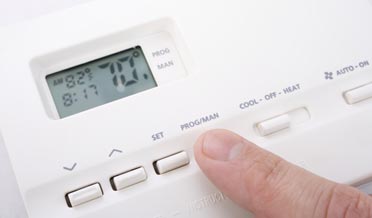Benefits of HVAC Zoning
It is hot!! Thank you, thank you, thank you for air conditioning! At these times, you might find yourself re-evaluating the comfort level in your home. The central air conditioner unit is running as designed, but you might have some spots in the home that are warmer than desired. In those cases, you might consider zoning the air conditioning in your home.
Normal central air conditioning should handle the normal home: a technician completed a load calculation to determine the proper size air conditioner needed for the space. However, not every home is normal, and some home features require more AC load than a normal system can handle. Such features include:
- A second story. This could include a finished basement during the heating season.
- Living space in an attic or above a garage.
- Rooms with high, vaulted ceilings.
- A sunroom, or spaces with large, south-facing windows.
- A large floor plan, with long duct runs.
One option to resolve the problems that arise from these features is an HVAC Zoning system. An HVAC Zoning system redirects conditioned air to increase comfort and efficiency. As a part of your re-evaluation, you might consider a zoned air conditioner system. Here are three versions of zoned systems with potential for your unusual home.
Dampened Air Conditioner Systems
A damper is a moveable plate, inserted into the ductwork to redirect and regulate airflow. For instance, the amount of cool air blowing into first-floor rooms can be reduced to prioritize second-story spaces. Without the damper, the first-floor space is adequately cooled, and the cooling cycle ended before the second-story space is comfortably cooled.
Manuel Dampeners. A simple solution is to insert a dampener in the ductwork at strategic locations to regulate airflow. The dampener is opened and closed manually according to personal comfort.
Automatic Dampeners. This system is connected to dual thermostats. One zone may call for cooling (or heating) and the other zone may not need cooling. The dampener ensures air moves to the appropriate zones. An automatic dampening system requires a blower motor with variable speed control.
Note: Dampeners tend to collect dust and other airborne particles. They require regular maintenance to prevent clogs in the ductwork and dust from interfering with operations.
HVAC Zoning: Dual Air Conditioner Systems
A dual air conditioner system adds a second air conditioner condenser and thermostat to handle the cooling needs of exceptional features. When this is completed during an air conditioner replacement, each air conditioning system should be smaller than the original system. A minimum amount of ductwork changes must be completed to create ductwork systems that service each zone. However, the resulting rise in comfort and efficiency can be remarkable.
HVAC Zoning: Ductless Mini-split Air Conditioner Systems
Ductless systems are a departure from the ordinary, but the results can be quite remarkable. This system uses a single condenser unit, but multiple zones receive cooling via external, insulated tubes. The tubes enter each zone and enter a wall unit that transfers the cool to the air. This system does not require ducts, but each zone has an individual thermostat. During the evening meal, the living room and kitchen can receive cool air, while the bedrooms don’t require the same amount of cool air. At bedtime, the cooling zones receiving cool air would be reversed. As you can imagine, the comfort level and efficiency of your air conditioner system are greatly improved.
If your home has special features that make air conditioning difficult, talk with your HVAC technician about a zoned air conditioner system.
HVAC Zoning can be complicated, give us a call and we can help!
Contact our HVAC Zoning experts at Doctor Cool & Professor Heat today at 281-338-8751 or email Doctor Cool and let our professional Residential HVAC Maintenance technicians assist with all of your AC services.
